Researchers are already finding microplastics in all environments and organisms. There is still no clear opinion about the dangers of micro- (particles less than 5 mm) and nanoparticles (less than 100 nm) plastic to humans and to the terrestrial biota in general. Apparently, common plastics such as polyethylene and polypropylene are harmless in themselves. However, additives added by manufacturers to plastics to improve their performance properties and which are secret know-how to society and regulatory authorities can cause serious harm to the environment. And most importantly, plastic particles are adsorbents and carriers of chemical and bacterial pollution.
One of the main components of microplastics are synthetic fibers such as nylon, polyester, polypropylene and acrylic, which are used to make fabrics. When washed, fibers end up in sewer drains and eventually end up in the ocean. According to some estimates, between 4.8 and 12.7 million tons of various plastics enter the world’s oceans each year, and microplastics account for about a third. Fibers, in turn, make up up to 90 percent of microplastics.
Researchers have already found microplastics in a wide variety of animal species: microfibers were found in 60 percent of macroinvertebrates, 49 percent of shorebirds, and a variety of fish. Throughout their lives, fish absorb large amounts of microfibers. It was previously reported that microplastic fibers did not stay in fish’s guts longer than other food components, and another six-week experiment found that microfibers caused damage to the mouth and gut folds of fish.
Today, science is at the stage of accumulating knowledge in the study of microplastics. Scientists do not know for sure how much and what kind of plastic is contained in different natural environments. So far, there are no unified methods for sampling contaminated environments, nor agreed upon methods of analysis and experimental design. Biologists, oceanologists, ecologists, chemists and physicists use completely different types of approaches in research.
There is a huge gap in research methods and objects between “laboratory” specialists and “natural” ones. The former often conduct experiments in ideal laboratory conditions on artificially simulated objects, sometimes even on mathematical models. Often, experiments set environmental conditions that are impossible for real objects.
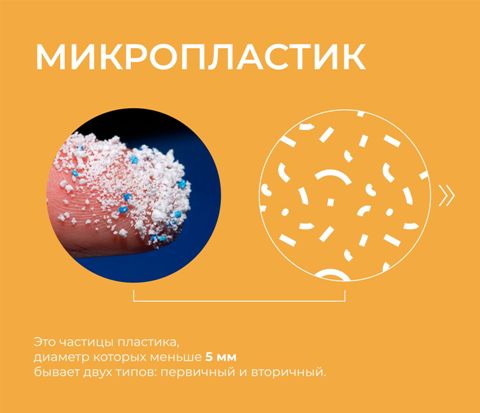
In natural conditions, researchers have a completely opposite problem. Large microplastic particles, especially visually visible ones, can be easily isolated from the environment. And microparticles and the contaminants they carry are extremely difficult to isolate and identify. Huge volumes of air, water and soil must be processed to extract sufficient amounts of microplastics for analysis. At the same time, the instruments used for analysis sometimes vary greatly. In addition, many researchers limit themselves to simply stating the presence of plastic in a given environment, without assessing its mass and what kind of pollution is associated with it, which makes it difficult to assess the severity of the problem.
Various non-standardized methods of collecting and processing environmental samples used by different groups of researchers lead to incomparability of results. A solution to the complex problem of assessing the impact of microplastics on humans and biota can only be found through close interaction between scientists from all relevant areas; at the same time, it is necessary to take into account comprehensive research and the development of standardized methods for studying the problem of microplastics.
Microplastics found in human blood
Scientists in the Netherlands have discovered microplastic particles in human blood for the first time. The shocking discovery was reported by the information resource LENTA.RU with reference to The Guardian. Previously, data had already been obtained on the ability of microplastics to accumulate in human organs and tissues.
Experts analyzed blood samples from 22 anonymous donors, all of whom were healthy adults, and identified plastic particles in 17 people. Half of the samples contained PET plastic, commonly used in drinks bottles, and a third contained polystyrene, used in food packaging and other products. A quarter of the blood samples contained polyethylene, the type used to make plastic bags.
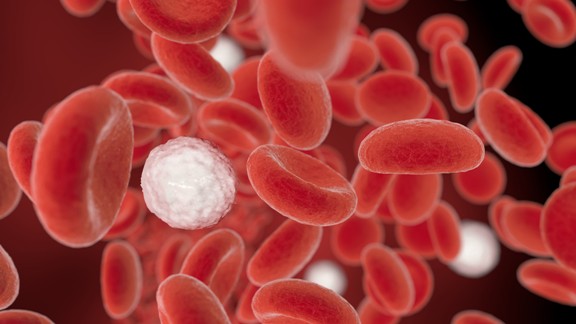
Scientists do not yet know what impact microplastics have on human health. However, experts are concerned that microplastics have proven harmful effects on human cells in laboratory conditions, and air pollution particles are already known to enter the body and cause millions of early deaths a year. Additionally, humans have been shown to ingest the tiny particles in food and water, as well as inhale them.
A recent study found that microplastics can cling to the outer membranes of red blood cells and limit their ability to transport oxygen. The particles have also been found in the placentas of pregnant women, and in pregnant rats they quickly pass through the lungs, penetrating the heart, brain and other organs of the fetus.
Microplastics in carotid atherosclerotic plaques increase the risk of a combination of myocardial infarction, stroke, or death from any cause
Researchers from Italy have found that the presence of microplastics in atherosclerotic plaques in the carotid artery increases the risk of a combination of myocardial infarction, stroke or death from any cause. As reported in The New England Journal of Medicine, the most common compounds found in plaques are polyethylene and polyvinyl chloride. Several studies have shown that microplastics and nanoplastics enter the human body through the gastrointestinal tract, lungs and skin, where they interact with tissues and organs.
Evidence from in vitro studies suggests that microplastics promote oxidative stress, inflammation, and apoptosis in endothelial cells. Animal models have shown that such exposure leads to changes in heart rate, impaired cardiac function, myocardial fibrosis, and endothelial dysfunction. However, it is unknown how clinically significant these observations are in humans. There is currently no evidence that microplastics can cause vascular damage in humans.
A team of scientists led by Raffaele Marfella from the University of Naples Luigi Vanvitelli conducted a prospective study that assessed the presence of these microplastics in surgically removed carotid plaques using pyrolytic gas chromatography-mass spectrometry, stable isotope analysis and electron microscopy. The researchers then examined the association between the presence of microplastics in plaque and the composite outcome of myocardial infarction, stroke, or death from any cause.
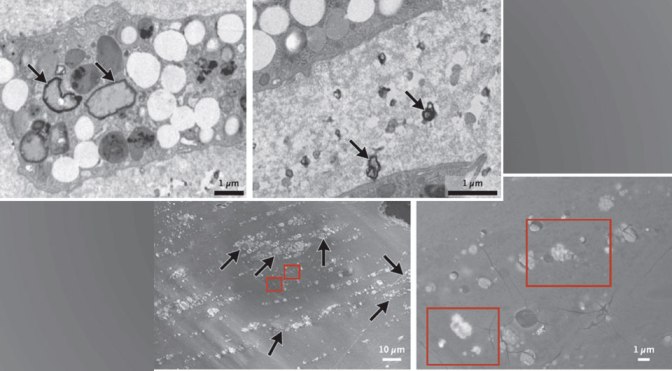
A total of 312 patients undergoing carotid plaque surgery were studied, with 257 patients included in the final analysis and followed for an average of 33.7 months. In 150 patients, a noticeable amount of polyethylene was found in the removed plaque (21.7 ± 24.5 micrograms per milligram of plaque), and in 31, a measurable amount of polyvinyl chloride was found (5.2 ± 2.4 micrograms per milligram of plaque). At the same time, doctors are not aware of obvious differences in the frequency of detection of microplastics depending on the place of residence of patients or the location of the medical center.
Transmission electron microscopy imaging in ten randomly selected patients showed the presence of particles with jagged edges in the foamy macrophages of the plaque. Almost all particles were smaller than one micrometer. Scanning electron microscopy showed reduced carbon and oxygen content in these particles and high chlorine content.
Stable isotope analysis showed that the ratio of carbon-13 to carbon-12 varied among patients without any obvious pattern. Linear regression analysis revealed a positive correlation between the amount of polyethylene present and the expression levels of interleukin-18, interleukin-1β, interleukin-6 and tumor necrosis factor-α, as well as the levels of CD3 and CD68 cells. The amount of collagen was reduced.
Patients with micro- or nanoplastics in carotid atherosclerotic plaque had a higher risk of heart attack, stroke, or death from any cause than patients without these substances in the plaque (hazard ratio 4.53, p < 0.001). The unadjusted hazard ratio was 2.84 (p = 0.007). The results of this study indicate that micro- and nanoplastics may significantly increase the risk of serious cardiovascular events. These data indicate a link between environmental pollution and deterioration in public health, so they are important for the development of interdisciplinary programs to reduce pollution levels.
Microplastic fibers cause gill damage and aneurysms in Japanese medakas, but increase egg production in females
It’s not just the fibers that they eat that end up in the fish’s bodies. Hundreds or even thousands of fibers pass through their gills with water every day. The gill apparatus and intestines are most exposed to microplastics, but laboratory studies of changes associated with exposure to fibers are not yet sufficient to draw conclusions about possible harm, reports the journal PLoS One.
A team led by David Hinton of Duke University decided to fill this gap and conducted a series of experiments with Japanese medaka (Oryzias latipes), a fish that spawns every day, making it much easier to study possible reproductive changes. Twenty-seven pairs of adult fish were randomly assigned to groups; a control group of nine pairs of fish was kept in clean water aquariums. Two experimental groups, also of nine pairs of fish, were kept in aquariums with a high content of polyester or polypropylene fibers, the most common synthetic fibers.
Each experimental group tank was supplemented with 10,000 fibers per liter of water, followed by the addition of 1,000 fibers per fish per day during water changes to correct for microfibers removed in fecal matter. The average length of polyester fibers in the experiment was 350 micrometers, polypropylene – 380 micrometers.
The experiment lasted three weeks, during which the researchers monitored the fish’s weight, egg production, and microfiber intake and absorption daily—how much fiber was coming in and how much was going out. The results of the experiment showed that the fibers did not lead to visible changes in condition or body weight, and did not affect embryonic mortality, egg development or hatching of juveniles. After the experiment was completed, the scientists examined the fish tissue to see what changes had occurred in the organs and tissues.
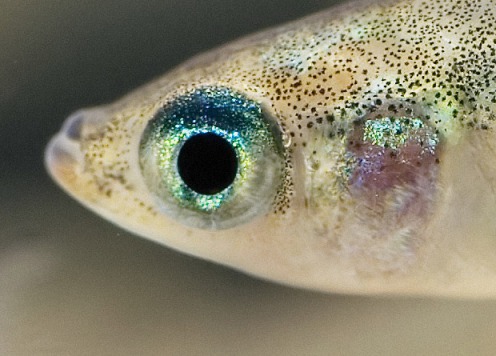
It turned out that a large amount of fiber contained in water, after passing through the gill cavity and intestines, causes acute and chronic changes in the body of fish. In particular, this led to structural changes in the gill plates, increased mucus production in the gills and intestines, the formation of aneurysms in the vessels and changes in epithelial cells. Scientists emphasize that changes in the gill apparatus can lead to a lack of oxygen, which makes the fish vulnerable to predators, less competitive in obtaining food and in the fight with other males for spawning.
The experiment showed that the females participating in the experiment began to produce more eggs over time. Statistically significant results (p < 0.05) were obtained for the experimental group with water containing polypropylene in the third week of exposure; the average number of eggs in this group was 14 pieces, while the control group had 12 eggs in the third week of exposure, although inside group did not reach statistical significance. Changes in the number of eggs are a common biomarker of endocrine disorders in fish, which may indicate the influence of microfibers on the endocrine functions and reproductive system of fish.
Researchers speculate that this is due to chemicals added to textiles. These are, for example, dyes or surfactants used to remove static electricity from synthetic fabric fibers. To answer questions about the mechanisms by which these chemicals affect fish, scientists will continue their research and analyze water and tissue samples obtained from this experiment.
Plastic stones found on an ecologically clean uninhabited island
There are few places on Earth as isolated as the uninhabited volcanic island of Trindade, which can be reached by boat in 3 to 4 days from the coast of Brazil. Rocks were found on the island, formed due to excess plastic floating in the ocean.
Laboratory analysis showed that the plastic was mainly formed from the remains of fishing nets – an extremely common type of litter in the ocean. The process of forming a new breed is simple. Currents throw fragments of nets onto the shore of the island; under the influence of sunlight, the plastic slowly melts, merging with the substrate – local stones. As a result, a new durable rock is formed. It already has a scientific name – plastiglomerates (plastic + agglomerate).

Similar rock-plastic formations have been recorded in Hawaii, Great Britain, Italy and Japan since 2014. But Trindade Island is the most remote place on the planet where plastiglomerates have been discovered. “It was all the more terrible to find them on one of the most environmentally friendly beaches,” the scientists comment. They fear that as the rocks erode, microplastics will be released into the environment and further pollute the island’s food chain, according to the journal Marine Pollution Bulletin.
Artificial objects become a trap for marine animals and lead to their death
Hermit crabs, unlike most crabs, are born with soft bodies and independently choose a protective shell for themselves. As they grow, they drop their defenses and look for a larger one. Today, plastic and other waste have become so infested on beaches around the world that crayfish have resorted to using plastic cups, bottle caps, light bulb sockets and other similar debris as shells.
As they write in the journal Science of The Total Environment, similar behavior of hermit crabs is observed on a global scale. Researchers found 386 individuals wrapped in trash around the world. About 85% of them used plastic waste, the rest used metal, glass and other materials.
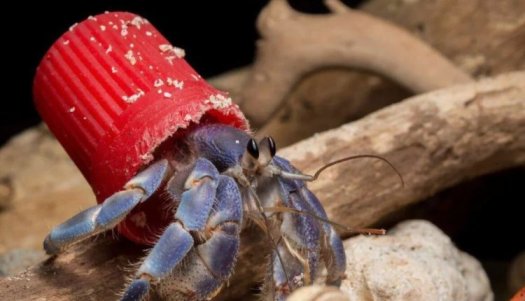
Trash is easier to find and easier to carry than a traditional shell. In addition, it provides better camouflage, and the color and smell of the plastic attracts a partner. Research shows that crabs like the chemicals released by plastic products. This is why crabs prefer trash to shells. However, such a choice leads to the death of animals. Often the artificial shell becomes a trap for them. So, off the coast of Australia alone, more than half a million hermit crabs died due to trash shells.
Additional sources of microplastics in the ocean
Canadian scientists have found that the source of most of the microplastics polluting the Arctic is not plastic waste at all, but ordinary household laundry. For every cubic meter of ocean water there are on average 40 microplastic particles. 92.3% of these are fibers, 73.3% of which are polyester. The source of these fibers is the washing of synthetic fabrics, since wastewater treatment plants are not yet capable of filtering out microplastics—they pass through more than 20 billion particles each year.
American scientists have found that up to 30% of microplastics entering the World Ocean are particles from car tires that are released when driving. They mix with road dust, enter the soil, groundwater and atmosphere, and are also distributed with precipitation.
A way to get rid of this source of microplastic emissions was proposed by a group of British design students – they developed a device that is attached to wheels and captures up to 60% of rubber particles. Collected microplastics are proposed to be reused in the production of dyes, soundproofing materials and 3D printing.
Removing microplastics from drinking water
Research shows that microplastics are particularly common in tap water. However, new research suggests that a possible low-tech solution for removing microplastics is boiling. In the experiment, the researchers created models of tap water, which is typically laden with minerals and plastic particles, and found that boiling it for five minutes and passing the liquid through a filter reduced exposure to nano- and microplastics by 90 percent. According to the study, when the calcium carbonate mineral becomes solid at high enough temperatures, it traps plastic particles and can be filtered out through a coffee filter.
“It’s important to note here that the effectiveness of trapping these micro/nanoplastics in these mineral solids depends on how hard and mineral-laden the water is: the harder the water, the more solids are produced, the more microplastics are trapped,” Anya Brandon told Healthline , associate director for U.S. plastics policy at the Ocean Conservancy and an environmental engineer who was not involved in the study.
While the study authors cautioned that further research is needed before recommending this practice on a large scale, there is no harm in trying it. Scientists told the Washington Post that people should wait 5 to 10 minutes after boiling to allow solids to settle and the water to cool, then filter.




